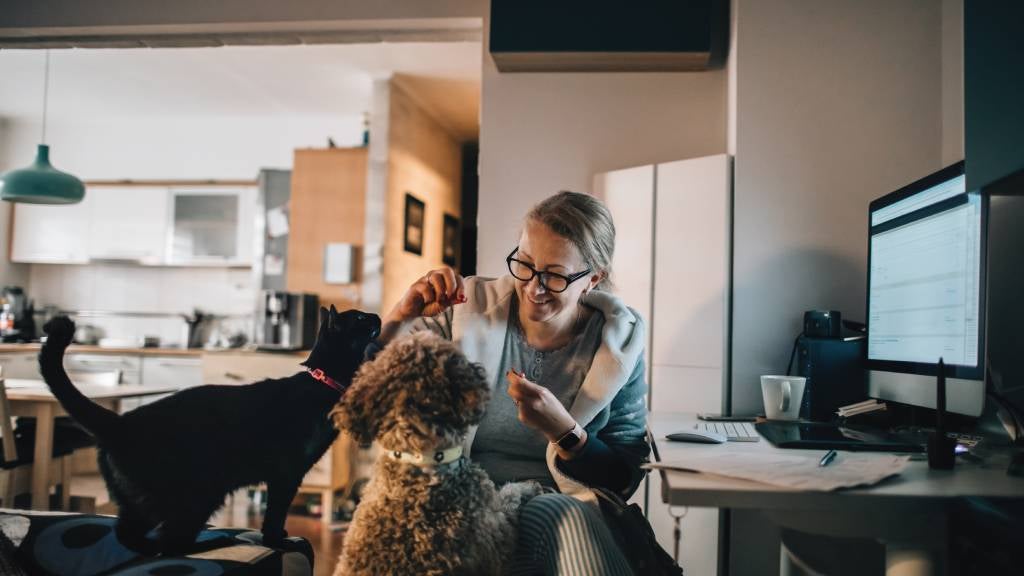How to tell if your dog or cat really loves you

Isn't it the best feeling when your cat curls up next to you, or when your pup greets you with an ecstatic wagging tail when you come home? But sometimes, it may leave you wondering, "Does my dog love me?" or "Is my cat showing affection, or just seeking some kai?" Well, you're not alone.
So let's take a deep dive into the language of love - pet style - and debunk some common misconceptions along the way, keeping in mind the different behaviours of dogs and cats.
Interpreting body language
Telling tails
With a lack of shared language between humans and animals, we often rely on body language to communicate.
Most of us are familiar with a dog's wagging tail, but did you know cats also have their own tail language? A high, upright tail is used as a friendly greeting, while a flicking tail may indicate agitation or aggression.
Relaxed posture
Does your pet love to lounge around with you? Relaxing and resting close to you is a sign of companionship and trust. Whether it's cuddled up on the couch or just lying near your feet, this relaxed posture is an indication of love.
Gaze and eye contact
Eye contact can be tricky to decode. In human interaction, it often signifies attention and interest. For pets, its meaning varies with the context. A dog's gentle gaze can release oxytocin (the love hormone), while a long, intense stare may assert dominance and cause anxiety. You’ll know your stare is a bit much when your dog avoids your gaze.
Physical affection
One of the most obvious signs of love from your pet is their desire for physical contact. This can be in the form of cuddling, leaning against you, or even resting their head on your lap. Just like with humans, closeness and touch can strengthen bonds.
Common misconceptions
Let’s debunk some common misconceptions so you can understand your pet better.
- Cats are solitary - cats are commonly thought to be independent and aloof, and while this can be true in some scenarios they still want and need social interaction. Your cat may engage with you with proximity, vocalisations, play, and physical touch.
- A wagging tail means a friendly dog - while this is true in most cases, a wagging tail can also indicate a range of other emotions. Pay attention to the other body language signs.
- A purring cat is always happy - while most people associate purring with contentment, cats can also purr when they are injured or in pain.
- A cat showing their belly means they want a belly rub - some cats might not enjoy having their bellies rubbed, however, displaying their tummy is a sign of trust.
- Belly rubs - according to SPCA sometimes dogs roll over and show their bellies (usually combined with a tucked tail) as an appeasement gesture when they are nervous. Those dogs are asking to be left alone, not for belly rubs.
How do cats show affection?
Purring
Cats often show affection by purring, a gentle vibration that indicates contentment, happiness, or even healing.
Kneading behaviour
Another unique way that cats show affection is through kneading, also known as "making biscuits". This behaviour mimics the instinctual action of kittens nursing and can be seen as a sign of comfort and contentment from your cat.
Slow blinking
The slow blink is one of the most endearing ways cats communicate. It's often called a "kitty kiss" and signifies trust. By closing their eyes in your presence, they're saying, "I feel safe and comfortable with you." You can show love back with a slow blink.
How do dogs show affection?
Tail wagging
A dog's wagging tail is commonly considered a classic sign of affection. Different tail wags can convey different emotions. A broad, side-to-side wag indicates a happy greeting or excitement, however a low and slow wag suggests uncertainty or fear.
Licking
Dogs show affection by licking, a soggy but endearing sign of love. Puppies lick to bond with their pack and show respect. When your pooch gives you a slobbery lick, it's usually an expression of affection.
Body contact
Many studies show that giving a dog a human hug can cause , but that doesn’t mean your dog doesn’t like to be close to you. Whether snuggling on the couch or curling up in bed, it's a sign of love and comfort. This physical affection releases oxytocin, strengthening the bond between you and your dog.
Whether canine or feline, our pets have their own unique ways of expressing love and affection. In return, we owe it to them to provide the best care possible. SPCA Pet Insurance help you protect your pets. Remember, a happy pet is a healthy pet!
27 Feb 2024